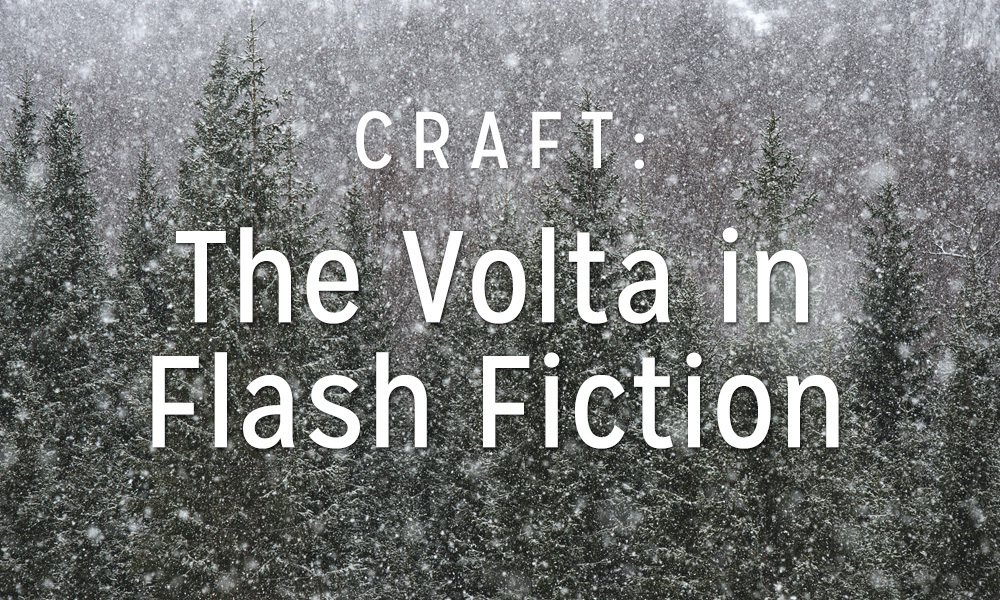With our Flash Fiction Contest wrapping up at the end of this month, we thought we should return to this craft essay on flash fiction, first published last November: In poetry, the volta is a common technique: found often in sonnets, the turn can be found now in a multitude of poetic forms. Unsurprisingly, the volta can be found in flash fiction, too, as the forms are often closely linked. In this craft essay, editor-in-chief Cole Meyer examines in depth the use of the volta in Ann Beattie’s 1983 neorealist “Snow.”

The volta, the turn, the fulcrum, in poetry, is a well-established technique: the shift in focus, the swerve in direction. But no one seems to talk about the volta in flash fiction. That moment, often near the end, when the skilled flash fiction writer takes your stomach and flips it inside out with her shift toward the heart of what she’s writing about. An example of what I mean may help.
In Ann Beattie’s “Snow”, first published in Vanity Fair in 1983 and later collected in Where You’ll Find Me, the narrator reflects on the time she spent in a house in the countryside with a former lover. The story begins, “I remember the cold night you brought in a pile of logs and a chipmunk jumped off as you lowered your arms.” This line is important, not just in the usual This is the opening line of a story way, but for the turn that comes later. It establishes two things: the first-person direct address, and the distance between the point-of-telling for the narrator and the moment of narrative. That distance is key. We know that the narrator has had room to reflect on this moment, that she has gained a kind of insight that will be invaluable for the story. This prepares us for the turn.
The first half of the flash is idyllic. We see images of “white-gold trellises” and “knee-deep snow” and her lover in a “white towel turban, like a crazy king of the snow.” These are happy, intimate memories. Their visitors, inspired by the fireplace, “tell amazing stories.” The final line before the turn reads, “The world outside the car looked solarized.” Right before Beattie flips the story, she gives us one final look at the memory too happy and serene to be entirely real: it’s overexposed, too bright out there in the fresh snow.
“You remember it differently.” And here we’ve arrived at the turn. Four short words that turn the story in a new direction. We knew this time at the house in the country would end; we knew it couldn’t all be so lovely and romantic. We knew it from the first line of the story. Something had to give. “You remember it differently.” The other side to the story. “The cold,” we’re told the lover remembers, “settled in stages.” The language here becomes muted. “Black,” and “dark,” and the amazing stories their visitors had told become “the same stories people always tell.” Even the details the narrator allows herself to remember after the volta, not from her lover’s perspective, have this same almost bleak quality: Their old neighbor Allen has died. The day she visited it rained and rained. Their old house only hosts “three or four crocus,” and she feels “embarrassed for them.” And in the story’s conclusion, mention is made at last “of the snowplow that seemed always to be there, scraping snow off our narrow road.”
The volta in “Snow” is dependent on this masterful control of language, the carefully selected details, the two sides to the story. But voltas can be utilized in any number of ways. In character, as in Aimee Bender’s “Appleless”, in which the first sentence of (almost) every paragraph uses either the singular or plural first person, (“The rest of us…”, “We suck water off the meat,” “We close in; we ring her”) and the final two paragraphs shift to the third person (“She cries through it all,” and “She never comes by the orchard again”). In tense, as in Kevin Leahy’s “Simple Physics”, which moves from past tense in collective memory, to present tense in the singular memory: “Here’s what I alone remember:”. They can even occur between the title of the story and the very first sentence, as in Lydia Davis’s “City People” which begins, “They have moved to the country.”
An exercise:
In “Snow,” Beattie gives us the skeleton of a story: “Somebody grew up. Fell in love, and spent a winter with her lover in the country.” Give the skeleton flesh, make it your own. Write the story first from the narrator’s perspective, and then from her lover’s. Where do the details diverge? How can you reconcile the two versions to make a narrative that hinges on the differences?
by Cole Meyer
